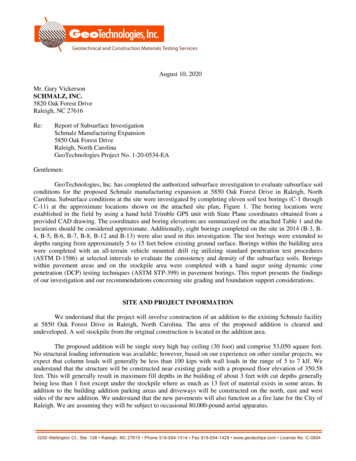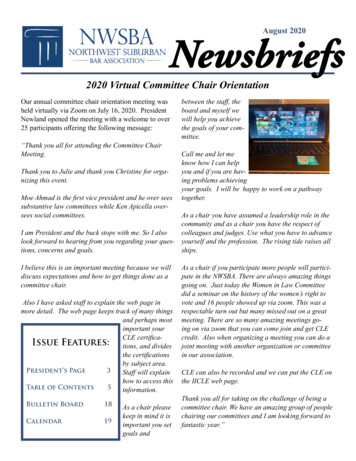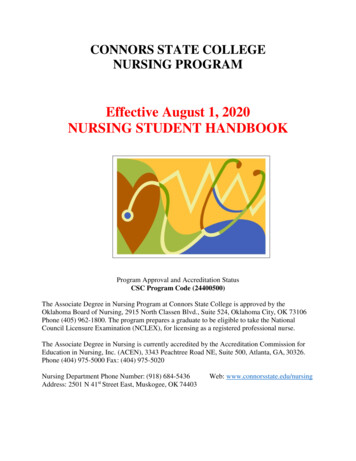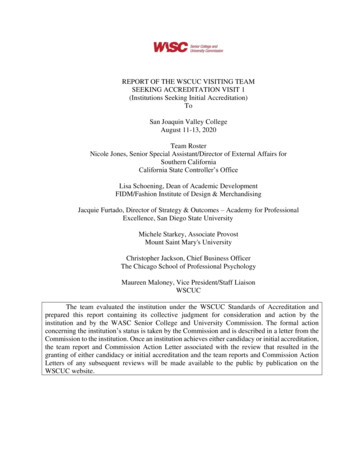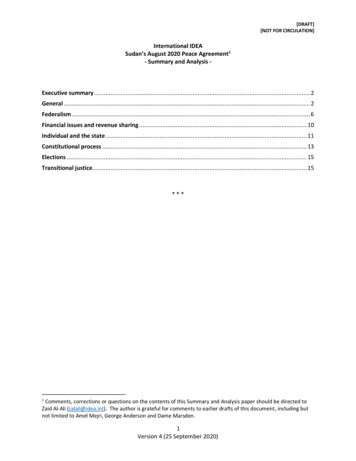
Transcription
[DRAFT][NOT FOR CIRCULATION]International IDEASudan’s August 2020 Peace Agreement1- Summary and Analysis -Executive summary . 2General . 2Federalism . 6Financial issues and revenue sharing . 10Individual and the state . 11Constitutional process . 13Elections . 15Transitional justice. 15***1Comments, corrections or questions on the contents of this Summary and Analysis paper should be directed toZaid Al-Ali (zalali@idea.int). The author is grateful for comments to earlier drafts of this document, including butnot limited to Amel Mejri, George Anderson and Dame Marsden.1Version 4 (25 September 2020)
[DRAFT][NOT FOR CIRCULATION]International IDEASudan’s Peace Agreement2- Summary and Analysis -Executive summaryAt the end of August 2020, a number of agreements (referred to as ‘protocols’) were signed betweenSudan’s Transitional Government and representatives of a number of armed groups. It is anticipatedthat these protocols will form part of a final agreement that will be signed on 3 October 2020, which willinclude an implementation mechanism. This version of the Summary and Analysis therefore focusesentirely on the agreements that were signed in Juba at the end of the August 2020. An update will beprepared and circulated after the final agreement is signed in October 2020.The agreements that were signed in Juba at the end of August 2020 are very comprehensive. Theyinclude long lists of agreed upon principles, arrangements on issues such as power sharing, revenuesharing, transitional justice, transitional security arrangements, and also establishes timetables for manyof these areas. At the same time, the agreements do not resolve how many of the issues will beimplemented in practice, and much is left to be resolved through legislation (including for example, theinternal structure of federal regions and the composition of revenue sharing commissions). These willneed to be resolved in the coming weeks and months. Because of the manner in which the negotiationshave taken place, there is good reason to believe that the parties will likely reach agreement on theseoutstanding issues. The challenge however will be to make progress within a reasonable timeline, to doso in a manner that creates an effective system for the general population while maintaining peace, toensure that the resulting system enjoys some form of democratic legitimacy while continuing to makeprogress on interim governance issues.GeneralThis paper’s substantive focus. This paper provides a summary and analysis of the agreements thatwere signed in Juba in August 2020. The paper is mainly focused on the agreements constitutionbuilding elements (meaning their impact on Sudan’s constitution building process and on the futureconstitution’s substantive content). The paper will include some discussion of the context and of otherelements as well.Updates to this paper. The agreements that were entered into during the last few days of August 2020are highly complex, and run into the hundreds of pages. The process of reading and rereading thevarious texts, and the implementation process will draw attention to provisions and arrangementswhose importance are not immediately obvious today. As a result, this Summary and Analysis paper willremain live, meaning that it will be regularly updated to take into account subsequent developments.The negotiations. The negotiations that led to the adoption of the agreements were mediated by theRepublic of South Sudan. According to individuals who were involved in the negotiations, the mediators2Comments, corrections or questions on the contents of this Summary and Analysis paper should be directed toZaid Al-Ali (zalali@idea.int). The author is grateful for comments to earlier drafts of this document, including butnot limited to Amel Mejri, George Anderson and Dame Marsden.2Version 4 (25 September 2020)
[DRAFT][NOT FOR CIRCULATION]approached their mediation role with a relatively light touch. The substance of the agreement waslargely negotiated between the Sudanese themselves, with some limited logistic and technical supportfrom the international community. The negotiations were also partially defined by the fact that many ofthe negotiators from the two sides were previously comrades in opposition to the former ruling party,which made the act of reaching agreement much less challenging than in past rounds of negotiations.The main parties to the negotiations include but are not limited to:(i)(ii)(iii)Sudan’s transitional government;The Sudan Revolutionary Front (a broad alliance of armed movements from Darfur and the TwoAreas and smaller unarmed groups from Eastern, Northern and Central Sudan);Sudan Liberation Movement/Minni Minawi (a Darfur armed movement).The agreement(s). The agreements that were signed at the end of August 2020 include a large numberof documents, each of which was signed by its own series of negotiating parties. For now, the partieshave not yet agreed to a single umbrella agreement that brings all these individual agreements togetheror that groups together all the arrangements that impact specific subject matter areas (as noted above,this is currently expected to be signed in early October 2020). Instead the agreements consists of atleast the following individual agreements:TitleSignatoriesScopeThe Agreement onNational Issues(hereinafter “ANI”)Sudan transitional government1 South Kordofan and Blue NileGroup3 Darfurian groups1 Nubian/north eastern group1 Central Sudanese group2 East Sudan groups1 Northern groupThe ‘National Coalition’( )التحالف الوطني Substantive scope: Power sharing,administration of the national capital,national commissions, theconstitutional conference, theconference on system of government,judicial reform, elections, other issues(environment, Christians andmembers of other faiths, anti-racismlegislation, etc.)The Final PeaceAgreement on the caseof Sudan in the twoareas (hereinafter the“Blue Nile and KordofanAgreement”).Sudan transitional governmentGeographic scope: Blue Nile, SouthKordofan, West KordofanSubstantive scope: Allocation ofresponsibilities, financial resources,civil service reform, reconstructionand development, environment, etc.Agreement on the finalsecurity arrangementsSudan transitional governmentThe Popular Movement for theLiberation of Sudan – North /the Revolutionary Movement( – الحركة الشعبية لتحرير السودان )شمال \ الجبهة الثورية The Popular Movement for theLiberation of Sudan – North /the Revolutionary MovementSubstantive scope: Permanentceasefire, DDR( – الحركة الشعبية لتحرير السودان )شمال \ الجبهة الثورية There are sevenseparate agreementsthat relate specifically toDarfur (hereinafter“Darfur Agreement”).Sudan transitional governmentThe Armed StruggleMovements – Darfur Path( )حركات الكفاح المسلح – مسار دارفور Geographic scope: North Darfur,South Darfur, West Darfur, EastDarfur, Central DarfurSubstantive scope: Power sharing,revenue sharing, permanent3Version 4 (25 September 2020)
[DRAFT][NOT FOR CIRCULATION]TitleSignatoriesScopeceasefire, transitional securityarrangements, etc.Agreement between thetransitional governmentof the SudaneseRepublic and theSudanese RevolutionaryFront – Northern PathSudan transitional governmentSudanese Revolutionary Front– Northern Path( الجبهة الثورية السودانية – مسار )الشمال Implementation. Discussions are still ongoing in Juba to draft and agree a single implementation matrixconsolidates all the deadlines and implementation arrangements into a single document, and that alsodetermines which specific parties or institutions will be mainly responsible for overseeing theimplementation of each specific topic. In the event such an agreement is signed, this paper will beupdated.Holdouts. Two of the main rebel groups did not sign on to the August 2020 agreements. In particular:(i)(ii)Sudan People’s Liberation Movement – North (led by Abdalaziz Adam Alhilu). The SudanPeople’s Liberation Movement – North agreed to join the negotiations in Juba but insisted onhaving its own separate peace track and to sign its own agreement. The Sudan People’sLiberation Movement – North also insisted on the establishment of a secular state as aprecondition for peace, which caused for the negotiations to stall. The Sudan People’sLiberation Movement – North did sign a very short agreement with the Prime Minister in AddisAbaba on 3 September 2020, but the agreement’s legal status is unclear (see below); andSudan Liberation Movement (led by Abdel Wahed Mohamed Nour). The Sudan LiberationMovement has said that it does not recognise the transitional government as legitimate becauseit contains a military component, and so therefore did not participate in the negotiations at all.It has been reported in the media that the signatories to the agreements have made arrangements thatwould allow for the holdouts to sign on to the peace agreement at a subsequent date. That account isnot accepted by individuals who were involved in the negotiations, according to who none of thenegotiators have any expectation that the holdouts will accept to adhere to the same terms as thosethat were agreed in August 2020.Complexity. The agreements that were signed in late August 2020 are highly complex mainly because ofthe way in which the different agreements relate to each other. This is to be expected given theiroverall length and given the difficulty that necessarily arises when managing such a complicatednegotiation process. However, there is an added level of complexity that stems from the fact that eachof the bilateral agreements has national level implications. The drafters made an effort to consolidateprovisions relating to some areas in the same sections in some of the individual agreements, but thiswas not done systematically, which makes the agreement more difficult to read and understand. Forexample:(i)On revenue sharing, the Blue Nile and Kordofan Agreement includes key provisions but one ofthe Darfur Agreement’s revenue sharing protocol provides for key arrangements that the4Version 4 (25 September 2020)
[DRAFT][NOT FOR CIRCULATION](ii)(iii)national level that will impact the country as a whole, including those parts of the country thatdid not sign on to these particular bilateral agreements;On the composition and functioning of national level institutions, readers will have to readtogether hundreds of provisions that are set out in individual bilateral agreements;On the constitutional process, relevant provisions are spread throughout the document ratherthan being concentrated in a single section.What this means is that we may discover more and more about the agreement as we continue readingand rereading it. It may also be the case that the signatories may discover that some of thearrangements are not compatible with each other, or that they are not particularly happy with thearrangements that they did not sign on to. Where there is great distrust between the parties, this canbe majorly problematic and can contribute to a breakdown of the entire peace process. In this case,time will tell whether the new revolutionary atmosphere has created enough good will between theparties to overcome these problems as they occur.Legal status. Virtually all of the agreements make reference to the 2019 Constitutional Charter. Manyreconfirm the relevant signatories’ commitment to the Charter’s section on rights and freedoms. At thesame time, some of the individual documents go further and purport to substantially amend theConstitutional Charter’s contents. In particular:(i)(ii)(iii)The Blue Nile and Kordofan Agreement provides that its provisions are part of the 2019Constitutional Charter (Article 112). The wording on this point is actually very strong andsignificant and is worth quoting. It provides that “this agreement is an inseverable part of theConstitutional Charter and in the event of a contradiction the provisions of this agreementprevail”.The Darfur Agreement provides that the signatories agreed to “include the signed peaceagreements [sic] in the Constitutional Charter and in the event of a contradiction, thecontradiction shall lead to an amendment of the Constitutional Charter [CHECK]”.The Charter itself provides that it can only be amended through an agreement by two thirds ofthe Transitional Legislative Council but presumably that is just a formality. What this means isthat the Charter is now dramatically changed, in ways that are not today entirely obvious.The Addis Ababa Agreement stands apart from the other agreements. It was not negotiated or signed inJuba. It is a single page, and was signed by the prime minister as opposed to a member of thetransitional government’s negotiating team. The Agreement does not purport to be directly enforceable(as opposed to some of the other agreements). It is therefore of questionable legal value, even thoughits political importance cannot be disputed (see below).Transitional period. The ANI extends the Transitional Period. It provides that th
not limited to Amel Mejri, George Anderson and Dame Marsden. [DRAFT] [NOT FOR CIRCULATION] 3 Version 4 (25 September 2020) approached their mediation role with a relatively light touch. The substance of the agreement was largely negotiated between the Sudanese themselves, with some limited logistic and technical support from the international community. The negotiations were also partially .




